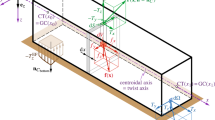Abstract
Models in the field of Applied Mechanics originate less from thought experiments but rather from technical problems. So does the so-called Winkler model: elastic beam on deformable foundation. It stems from the then (1870) High Technology the railway system. The question was: What is the stress state in a continuously bedded beam, the sleeper, loaded by singular rail loads? Winkler came up with a convincing closed form solution by linearising the behaviour of the subgrade which consists of a compressed layer of stones. The Winkler model is time-independent. The extension is to make the subgrade time dependent, in the simplest case to make it viscous. This also applies to the problem of a wheel set consisting of a beam ring, a rigid disc, and in between a pre-stressed rubber sheet. Such wheel sets are or have been in use in nowadays tram and railway systems. In this paper an analysis of such a rotating wheel set under a singular load is given. It is shown that the stress state in the ring beam depending on rotational speed decreases linearly with increasing rotational speed.
Similar content being viewed by others
References
Frýba, L.: History of Winkler foundation. In: Knothe, K., Grassie, S.L., Elkins, J.A. (eds.) Interaction of Railway Vehicles with the Track and its Substructure. Proceedings of the 3rd Herbertov Workshop held at Herbertov, Czech Republic, September 1994. Vehicle System Dynamics Supplement, vol. 24, pp. 7–12 (1995)
Knothe K.: Fiedlerbriefe und Bibliographie Emil Winklers. Dr. Erwin Rauner Verlag, Augsburg (2004)
Knothe, K., Tausendfreund, D.: Emil Oskar Winkler (1835–1888) – Begründer der Statik der Baukonstruktionen an der TH Berlin – Leben und Werk. In: 1799–1999 – Von der Bauakademie zur Technischen Universität Berlin, Katalog zur Ausstellung, pp. 164-176, Ernst & Sohn, Berlin (1999)
Levien, R.: The elastica: a mathematical history. Draft of Ph.D. thesis, UC Berkeley, Wikipedia, generated July 31 (2004)
Mahrenholtz O.: Elastic beam-like ring on a Winkler foundation. In: Katsikadelis, J.T., Beskos, D.E., Gdoutos, E.E. (eds) Recent Advances in Applied Mechanics, pp. 214–219. NTU, Athens (2000)
Mahrenholtz O.: Zur Elastomechanik des gebetteten Kreisringbalkens. Z Technische Mechanik 24, 264–270 (2004)
Pestel, E., Wittenburg, J.: Technische Mechanik, Band 2: Festigkeitslehre, 2., überarbeitete und erweiterte Auflage, B.I. Wissenschaftsverlag, Mannheim etc. (1991)
Szabo I.: Die Grundlegung der linearen Elastizitätstheorie für homogene und isotrope Körper. Technikgeschichte 40, 301–336 (1973)
Truesdell C.: Essays in the History Mechanics. Springer, Berlin (1968)
Winkler, E.: Vorträge über Eisenbahnbau, Heft 1, 2, Verlag H. Dominicus, Prag (1867)
Winkler, E.: Die Lehre von der Elasticitaet und Festigkeit – mit besonderer Rücksicht auf ihre Anwendung in der Technik, für polytechnische Schulen, Bauakademien, Ingenieure, Maschinenbauer, Architekten, etc., Verlag H. Dominicus, Prag, (1867)
Author information
Authors and Affiliations
Corresponding author
Rights and permissions
About this article
Cite this article
Mahrenholtz, O.H. Beam on viscoelastic foundation: an extension of Winkler’s model. Arch Appl Mech 80, 93–102 (2010). https://doi.org/10.1007/s00419-009-0364-4
Received:
Accepted:
Published:
Issue Date:
DOI: https://doi.org/10.1007/s00419-009-0364-4




